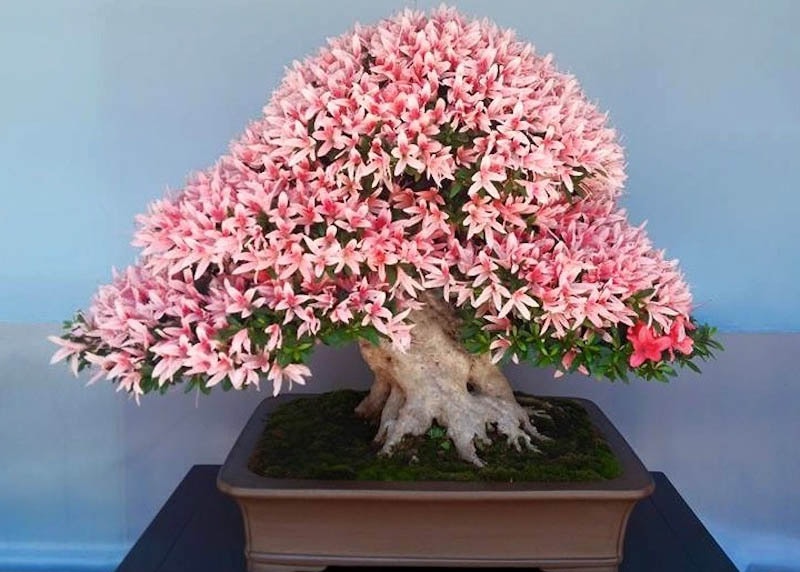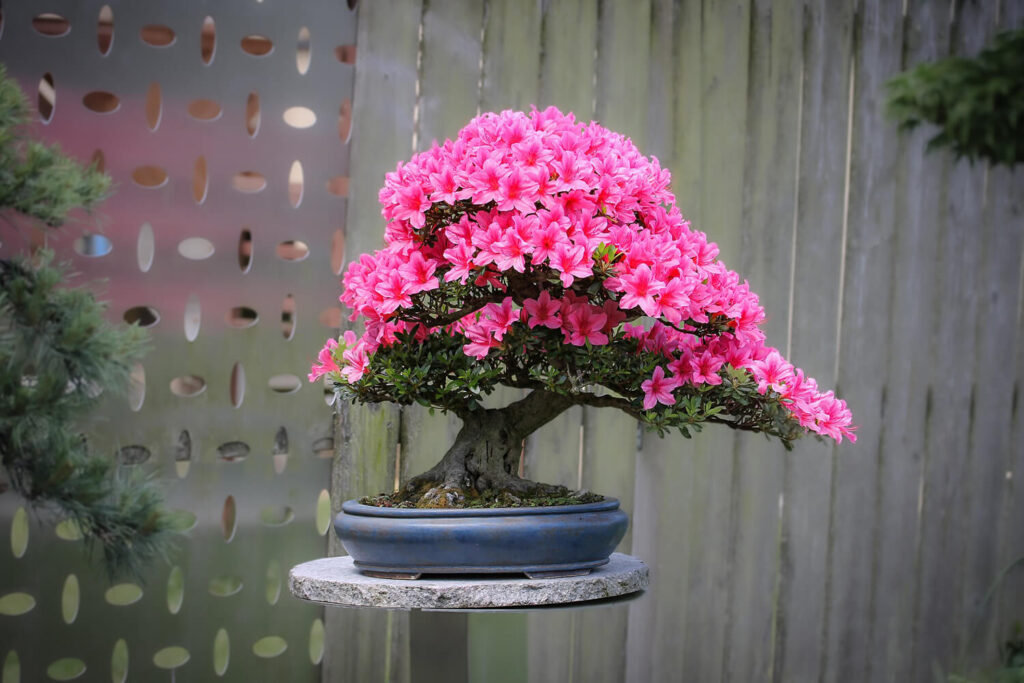Kurume Azalea Bonsai trees require regular watering and bright, indirect sunlight. Pruning and repotting are essential for healthy growth.
Kurume Azalea Bonsai trees are beloved for their vibrant blooms and compact growth. Originating from Japan, these bonsai trees thrive in well-draining soil and require careful attention to watering practices. They prefer bright, indirect sunlight and should be protected from extreme temperatures.
Regular pruning is necessary to maintain their shape and encourage flowering. Repotting every two to three years ensures the roots have room to grow and absorb nutrients. Proper care ensures these beautiful bonsai trees can flourish and bring a touch of elegance to any space. Whether you’re a beginner or an experienced bonsai enthusiast, understanding their needs is crucial for success.

Credit: www.bonsaisocietyvictoria.com.au
Introduction To Kurume Azalea Bonsai
Caring for Kurume Azalea Bonsai involves proper watering, pruning, and sunlight. This beautiful tree thrives with regular maintenance and attention. Ensure well-drained soil to prevent root rot and promote healthy growth.
History And Origin
Kurume Azalea bonsai trees come from Japan. They have been grown for hundreds of years. These trees are popular for their beautiful flowers. Kurume is a city in Japan where they first grew. The climate there is perfect for these trees.
Unique Characteristics
Kurume Azaleas have bright, colorful flowers. They bloom in spring and early summer. The leaves are small and shiny. These trees are perfect for bonsai because they stay small. The roots are strong and spread wide. This helps the tree stay stable in a pot.

Credit: www.bonsaiempire.com
Choosing The Right Kurume Azalea
Pick a plant with vibrant green leaves. Avoid plants with yellow or brown spots. Check the roots. They should be firm and white. Soft or dark roots are unhealthy. Look for compact growth. Spindly plants are weak. Ensure the plant has no pests or diseases. Inspect leaves for holes or webs.
Some varieties are easier to grow. Hino Crimson is hardy and blooms bright red. Kirin offers pink flowers and is very resilient. Coral Bells has stunning coral-colored blooms. Snow is great for white flowers and easy care. These varieties are ideal for beginners.
Ideal Growing Conditions
Kurume Azalea bonsai thrives in well-drained, slightly acidic soil. Provide partial shade and consistent moisture for optimal growth. Maintain high humidity levels to ensure healthy foliage and vibrant blooms.
Light Requirements
Kurume Azalea bonsai trees need bright, indirect light. Direct sunlight can harm the leaves. Place them near a window with filtered light. Avoid placing them in full shade.
Temperature And Humidity
These bonsai trees prefer temperatures between 60-75°F. They need consistent warmth to thrive. Avoid exposing them to freezing temperatures. Keep them away from drafty windows and doors. High humidity levels are crucial. Use a humidity tray under the pot. Misting the leaves can help maintain proper moisture.
Soil And Potting
Kurume Azalea bonsai trees need well-draining soil. Use a mix of akadama, pumice, and lava rock. This mix helps keep the roots healthy. Akadama retains moisture but drains well. Pumice provides aeration and retains water. Lava rock adds stability and helps with drainage. This soil mix ensures the tree gets enough air and water.
Repot Kurume Azalea bonsai trees every two years. Choose a pot with good drainage holes. Remove the tree from its old pot carefully. Trim away dead or long roots. Place fresh soil mix at the bottom of the new pot. Position the tree in the new pot and fill with soil mix. Water the tree well after repotting.
Watering Techniques
Kurume Azalea Bonsai trees need regular watering. Ensure the soil is moist but not soggy. During hot weather, water the tree daily. In cooler months, reduce watering to every few days. Always check the soil before watering. If the top inch feels dry, it’s time to water.
Overwatering can cause yellow leaves and root rot. Check the soil; it should not feel constantly wet. Underwatering leads to dry, crispy leaves. The soil will feel very dry to touch. Adjust your watering schedule based on these signs. Ensure proper drainage to avoid waterlogging.

Credit: hookedonbonsai.com
Fertilizing Your Bonsai
Use a balanced fertilizer for your Kurume Azalea bonsai. A fertilizer with equal parts nitrogen, phosphorus, and potassium works best. Organic fertilizers are often preferred for bonsai trees. They release nutrients slowly and help the soil. Avoid fertilizers with high nitrogen content. This can cause excessive leaf growth. Liquid fertilizers can be applied more easily. You can also use slow-release fertilizer pellets.
Fertilize your Kurume Azalea bonsai every two weeks during the growing season. The growing season is usually from spring to early autumn. Reduce the frequency during the late autumn and winter months. In these months, fertilize only once a month. Always water the bonsai before applying the fertilizer. This helps the plant absorb nutrients better. Over-fertilizing can harm your bonsai. Follow the instructions on the fertilizer package carefully.
Pruning And Shaping
Pruning and shaping Kurume Azalea Bonsai trees promote healthy growth and enhance their aesthetic appeal. Regular trimming helps maintain the desired form and encourages flowering.
Basic Pruning Techniques
Start pruning in early spring. Remove dead or weak branches first. Use clean, sharp scissors. Cut just above a leaf node. This encourages new growth. Don’t cut too much at once.
Wiring And Styling Tips
Use aluminum or copper wire for wiring. Wrap the wire around branches gently. Bend branches to desired shape. Check wires regularly. Remove them if they dig into the bark. Wiring helps create beautiful shapes.
Pest And Disease Management
Spider mites and aphids are common pests on Kurume Azalea bonsai. Check leaves regularly for tiny spots. Use a mild insecticidal soap to treat infestations. Scale insects can also be a problem. Remove them with a soft brush and soap solution.
Good air circulation prevents fungal diseases. Water the soil, not the leaves, to avoid leaf spot and powdery mildew. If leaves have white patches, use a fungicide. Yellow leaves can mean root rot. Improve drainage and avoid overwatering.
Seasonal Care Tips
Kurume Azalea bonsai trees need extra care in spring and summer. During these seasons, water the tree daily. Ensure the soil remains moist but not waterlogged. Provide the tree with morning sunlight and afternoon shade to protect it from intense heat. Use a balanced fertilizer every two weeks to promote growth. Prune new shoots to maintain the desired shape.
In fall and winter, reduce watering to prevent root rot. Water only when the soil feels dry. Move the tree to a cooler location with indirect light. Avoid fertilizing during these months. Protect the tree from frost by placing it indoors or in a sheltered area. Check for pests and treat any infestations promptly.
Troubleshooting Common Issues
Leaf drop and yellowing can be signs of stress. Overwatering or underwatering are common causes. Check the soil moisture. It should be moist but not soggy. Poor drainage can also lead to yellow leaves. Ensure the pot has drainage holes. Pests like aphids can cause leaf problems. Inspect the leaves regularly. Treat pests with appropriate solutions. Sometimes, lack of nutrients causes yellowing. Use a balanced fertilizer to keep the plant healthy.
Poor flowering may result from insufficient light. Place the bonsai in a spot with bright, indirect sunlight. Pruning at the wrong time can affect blooms. Prune after flowering to encourage new growth. Incorrect fertilization can also hinder flowering. Use a fertilizer high in phosphorus for better blooms. Stressful conditions, such as sudden temperature changes, can affect flowering. Keep the environment stable and suitable for the bonsai.
Conclusion
Caring for a Kurume Azalea Bonsai is rewarding. Ensure proper watering, pruning, and sunlight. With patience and attention, your bonsai will thrive. These vibrant plants can enhance any space. Remember to monitor for pests and diseases. Happy gardening!

